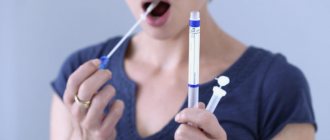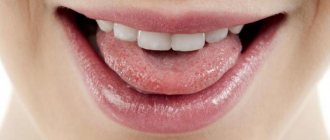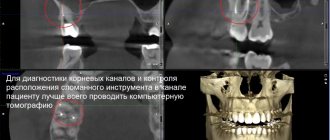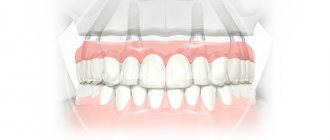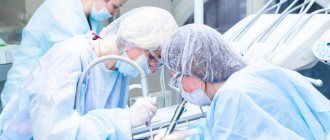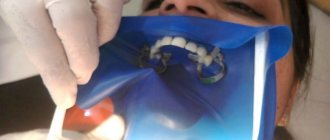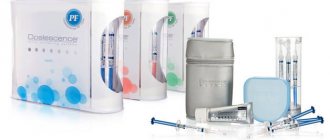The main cause of dental caries is the activity of bacteria in the oral cavity. But there are also a number of additional factors that can contribute to the development of this disease. One of these factors is saliva. How the pH of human saliva affects dental health will be discussed in this article.
In this article
- Why does caries develop?
- What is the role of saliva in maintaining oral health?
- What happens when there is insufficient saliva production?
- How does saliva pH affect teeth?
- Prevention of salivary disorders and dental caries
- Conclusion
Why does caries develop?
Scientists are still studying the mechanisms of the development of caries - one of the most common diseases on the planet. They agree that caries is caused by microorganisms living in the oral cavity, in the presence of associated factors. These factors include carbohydrate nutrition, poor oral hygiene, and the qualitative and quantitative composition of saliva.
How does the carious process develop and why do cavities form in teeth? Contrary to popular belief, microbes do not chew holes in teeth; caries develops differently. Cariogenic bacteria (one of the species is Streptococcus mutans) form colonies on the surface of teeth, collecting in a biofilm - dental plaque. These bacteria “love” foods rich in carbohydrates and ferment the sugars contained in them. The products of carbohydrate processing by bacteria are organic acids. So they harm our teeth and contribute to the development of caries.
Acids produced by bacteria disrupt the normal structure of the enamel, promote its demineralization, penetrate into the deep tissues of the tooth and continue to destroy it from the inside. The more microbes in the mouth, the more carbohydrates they receive, the higher the acidity on the surface of the teeth and the more active the process of their destruction occurs.
What is the role of saliva in maintaining oral health?
Saliva is the biological fluid of our body that is produced by the salivary glands. Constantly present in the oral cavity, saliva takes part in the digestive processes, nourishes tissues, provides natural cleaning of the oral cavity, and protects teeth and mucous membranes from bacterial exposure. All natural processes that occur with our teeth are carried out in interaction with this biofluid. Saliva ensures the normal functioning of all tissues and organs of the oral cavity; in particular, the important role of saliva in maintaining the mineral composition of tooth enamel has been proven.
In addition to water, saliva contains phosphates, calcium salts, fluorides, sodium compounds and other substances that help strengthen and maintain the health of tooth enamel. Essentially, salivary fluid is a solution supersaturated with calcium and phosphate salts. Due to this composition, saliva qualitatively mineralizes teeth. Medical research has proven that during teething, enamel matures primarily due to the active intake of calcium and phosphorus ions from saliva. It also maintains and, if necessary, restores the correct balance of minerals in already erupted teeth.
In addition to its mineralizing function, the protective role of saliva has been proven. It contains lysozyme and some other substances with bactericidal and bacteriostatic effects. Thanks to this, saliva neutralizes the action of pathogenic microorganisms and prevents the development of infections of the teeth and oral cavity. And finally, saliva performs a cleansing function, washing away food debris and germs.
Thus, normal quality and quantity of saliva is the most important condition for healthy teeth and oral cavity. Any violations of its quantitative or qualitative composition can provoke the development of caries, diseases of the mucous membranes and periodontium.
Saliva
Saliva
(lat.
saliva
) - colorless liquid secreted into the oral cavity by the salivary glands.
The characteristics of saliva secreted by different salivary glands are somewhat different. The integral characteristic is important for physiology, so the so-called mixed saliva
.
Characteristics of human saliva
The mixed saliva of a healthy person under normal conditions is a viscous, slightly opalescent liquid.
99.4–99.5% of human saliva is water. The remaining 0.5–0.6% are organic and inorganic components. Among organic substances: proteins (1.4–6.4 g/l), mucin (mucus) (0.8–6.0 g/l), cholesterol (0.02–0.5 g/l), glucose (0.1–0.3 g/l), ammonium (0.01–0.12 g/l), uric acid (0.005–0.03 g/l). Inorganic substances in saliva include anions of chlorides, bicarbonates, sulfates, and phosphates; cations of sodium, potassium, calcium, magnesium, as well as microelements: iron, copper, nickel, etc. The most important enzymes of saliva are amylase and maltase, which act only in a slightly alkaline environment. Amylase breaks down starch and glycogen into maltose. Maltase breaks down maltose into glucose. Saliva also contains proteinases, lipases, phosphatases, lysozyme, etc.
The acidity of saliva depends on the rate of salivation. Typically, the acidity of mixed human saliva is 6.8–7.4 pH, but with high salivation rates it reaches 7.8 pH. The acidity of the saliva of the parotid glands is 5.81 pH, of the submandibular glands - 6.39 pH. The density of saliva is 1.001–1.017.
Salivation
Salivation
or
salivation
(lat.
salivatio
) is carried out by many salivary glands, among which there are three pairs of so-called
major salivary glands
. The largest of them are the parotid salivary glands. They are located below and in front of the auricle, directly under the skin. Their weight is 20–30 g. The medium-sized ones are the submandibular salivary glands, weighing about 15 g. The smallest of the large salivary glands are the sublingual glands. Their weight is about 5 g and they are located under the mucous membrane of the floor of the mouth. The remaining glands are small.
Outside of food intake, the salivary glands secrete saliva at a total rate of 0.3–0.4 ml/min. The rate of basal salivation is from 0.08 to 1.83 ml/min, stimulated by food - from 0.2 to 5.7 ml/min. The total amount of saliva secreted per day in a healthy person is 2–2.5 liters. The parotid glands secrete 25–35% of the total volume, the submandibular glands – 60–70%, the sublingual glands – 4–5%, and the minor glands 8–10%. The saliva of the small glands has a high mucus content. By secreting no more than 10% of the total volume of saliva, they secrete 70% of all mucus.
The amount, chemical composition and characteristics of saliva change depending on the type of food eaten and other factors (smoking, taking medications), as well as with various diseases.
Salivation in children
Salivation in children under three months is insignificant and amounts to 0.6–6 ml of saliva per hour (with active sucking - up to 24 ml per hour). Starting from the age of 3–6 months, a child’s salivation increases significantly, reaching a volume close to that of adults by the age of 7 years. In school-age children, the volume of unstimulated salivary secretion ranges from 12 to 18 ml per hour. In children, the acidity of mixed saliva is on average 7.32 pH (in adults - 6.40 pH).
| Age, years | Salivation in healthy children, ml per 10 minutes (NIIDG, 1993) | |
| boys | girls | |
| 4–5 | 1,82 ± 0,22 | 1,84 ± 0,22 |
| 6–8 | 3,14 ± 0,39 | 3,59 ± 0,53 |
| 9–11 | 4,05 ± 0,37 | 4,01 ± 0,26 |
| 12–14 | 4,21 ± 0,21 | 4,12 ± 0,26 |
Still from “Saliva in Children” from a video lecture by E.V. Gostishcheva “Anatomical and physiological characteristics of the digestive organs in children. Methods and methods for studying the digestive system in children" for students of the Medical Academy named after S.I. Georgievsky Crimean Federal University named after V.I. Vernadsky
Functions of saliva
Saliva performs a number of important functions for the body: digestive, protective, remineralizing, trophic, buffering and others.
Saliva moistens, liquefies, and dissolves food. With the participation of saliva, a food bolus is formed. Saliva dissolves substrates for further hydrolysis. The most active salivary enzymes are amylase, which breaks down polysaccharides and maltase, which breaks down maltose and sucrose into monosaccharides.
Moisturizing and coating the oral mucosa with mucus contained in saliva protects the mucous membrane from drying out, cracking and exposure to mechanical irritants. By washing the teeth and mucous membrane of the oral cavity, saliva removes microorganisms and their metabolic products, as well as food debris. The bactericidal properties of saliva are manifested due to the presence of lysozyme, lactoferrin, lactoperoxidase, mucin, and cystatins.
This process of remineralization of dental tissue is based on mechanisms that prevent the release of its components from the enamel and facilitate their entry from saliva into the enamel. Saliva with normal acidity (pH from 6.8 to 7.0) is oversaturated with ions, especially Ca2+ and PO43+ ions, as well as hydroxyapatite (the main component of tooth enamel). With increasing acidity (decreasing pH), the solubility of enamel hydroxyapatite in oral fluid increases significantly. Saliva also contains mumps, which increases tooth calcification.
Saliva has high buffering properties, allowing it to neutralize acids and alkalis and, thus, protect tooth enamel from damaging effects.
Salivation disorders
In pathology, there are two possible variants of salivation disorders - hypersalivation and hyposalivation with its extreme degree of xerostomia (dry mouth) (Ionov A.Yu. et al.).
Hypersalivation:
- The patient complains of constant, increased salivation, often more during sleep. If salivation increases during meals, the patient usually does not notice this.
- When examining the oral mucosa, signs of hypersalivation may not be noticed, but copious salivation is possible during a routine examination of the oral cavity, with saliva quickly and in large quantities accumulating under the tongue and the anterior parts of the mouth.
- Hypersalivation is observed in acute inflammatory processes in the oral cavity, with irritation of the mucous membrane with iodine and other medications. Increased secretion of saliva is noted by patients with vagotonia - with peptic ulcers, gastritis, pancreatitis, helminthic infestation.
- Hypersalivation occurs in patients with psychasthenia, organic damage to the autonomic centers, chronic encephalitis, parkinsonism (up to 5-10 liters per day), post-stroke hemiplegia, mercury poisoning, and when taking iodine orally.
Hyposalivation:
- Hyposalivation - manifested by dry mouth, difficulty speaking, eating, chewing and swallowing solid food, pain, burning in the mouth, and a feeling of roughness of the tongue.
- On examination, the mucous membrane is poorly moisturized or dry, matte. The saliva produced is foamy, viscous, or absent. Cracks, erosions, foci of inflammation and necrosis form on the mucous membrane, and infection often occurs. Tooth enamel becomes dull and chalky, and tooth decay occurs.
- A decrease in salivation is observed in cases of taste disturbances, impaired nasal breathing, in the menopausal period with hypertension, with hypovitaminosis A, B1, B12, PP, E, with diabetes, collagenosis, radiation sickness, and diseases of the salivary glands. Xerostonia is characteristic of Sjögren's disease/syndrome.
- Palpation examination of dry mucosa is carried out only to confirm the patient’s subjective sensations and visual data. Usually limited to palpation of the tongue. With severe dryness of the mucous membranes, the finger does not slide over the surface of the tongue, the mucous membrane becomes rough and rough. We again emphasize the exceptional importance of studying the moisture of the tongue in the diagnosis of acute diseases of the gastrointestinal tract, blood loss, and peritonitis.
Scientific research, including the issues of salivation and saliva characteristics in diseases of the gastrointestinal tract
- Maev I.V., Barer G.M., Busarova G.A., Pustovoit E.V., Polikanova E.N., Burkov S.G., Yurenev G.L. Dental manifestations of gastroesophageal reflux disease // Clinical medicine. – 2005. – No. 11. P. 33–38.
- Novikova V.P., Shabanov AM Condition of the oral cavity in patients with gastroesophageal reflux disease (GERD) // Gastroenterology of St. Petersburg. – 2009. – No. 1. - With. 25–28.
- Pustovoit E.V., Polikanova E.N. Changes in the parameters of mixed saliva in patients with gastroesophageal reflux disease against the background of antireflux therapy // Russian Dentistry. - No. 3. – 2009.
- Egorova E.Yu., Belyakov A.P., Krasnova E.E., Chemodanov V.V. Metabolic profile of blood and saliva in gastroduodenal diseases in children // Bulletin of IvSMA. — Vol. 3. - 2005. pp. 13-19.
- Eremina N.V., Yurchenko I.N., Dyagilev V.V., Lunev A.V. The effect of smoking on the content of slgA in saliva and laryngopharyngeal secretions in patients with laryngitis and GERD // Proceedings of the Samara Scientific Center of the Russian Academy of Sciences. – v. 11. – No. 1(5). – 2009. pp. 950-954.
- Moseeva M.V., Khokhlacheva N.A. The influence of dental preventive measures on the aggressive-protective potential of the stomach with erosive and ulcerative lesions of the gastroduodenal zone // Practical Medicine. 2013. No. 4 (72) September. pp. 70–74.
- Novikova V.P., Shabalov AM The condition of the oral cavity in patients with gastroesophageal reflux disease (GERD) // Gastroenterology of St. Petersburg. – 2009. – No. 1. - With. 25–28.
- Storonova O.A., Trukhmanov A.S., Dzhakhaya N.L., Ivashkin V.T. Violations of esophageal clearance in gastroesophageal reflux disease and the possibility of their correction // RZHGGK. 2012. T. XXII. No. 2. pp. 14–21.
- Ivannikova A.V. Differential diagnostic criteria for the condition of the oral cavity in patients with GER. Abstract of dissertation. PhD, 01/14/14. – dentistry. MGMSU named after. A.I. Evdokimova, Moscow, 2019.
- Egorova E.Yu. Diagnosis and correction of changes in the blood-salivar barrier in gastroduodenal diseases in children. Abstract of thesis. Ph.D. 14.00.09-pediatrics. Ivanovo, 2004.
- Tumashevich O.O. Dental syndrome in gastroesophageal reflux disease, its diagnosis and prevention. Dissertation for the scientific degree of Ph.D. 01/14/14 – dentistry. Tver, 2022.
On the GastroScan.ru website in the “Literature” section there is a subsection “Oral diseases associated with gastrointestinal diseases”, containing publications for healthcare professionals on this topic. Back to section
What happens when there is insufficient saliva production?
According to statistics, every fifth adult is diagnosed with xerostomia, or dry mouth. This condition is caused by the fact that a person has reduced or completely absent saliva production. Since this biofluid performs a number of important functions, with xerostomia negative changes occur in the oral cavity:
- discomfort occurs;
- the level of hygiene of teeth and gums decreases;
- Due to a lack of saliva, the pH of the oral cavity decreases, microbes actively multiply in the mouth, and dental caries may begin to develop.
How does saliva pH affect teeth?
One of the protective elements of saliva is the so-called buffer system. Its task is to neutralize the negative effects of acids entering the oral cavity. Buffer systems maintain a normal pH level in the oral cavity, providing protection against acid-base influences. It is the buffer systems of saliva that influence the restoration of the pH of the oral cavity within minutes after eating.
If the pH of saliva is disturbed, buffer systems do not cope with their task and cannot neutralize acids. This leads to the fact that tooth enamel quickly loses mineral substances, caries develops, as well as non-carious lesions of dental tissues.
Dietary habits and poor oral hygiene can affect changes in the pH level of saliva, and therefore play a role in the development of caries. Some diseases and conditions also affect the process of salivation. For example, with Sjogren's syndrome and diabetes, saliva production decreases, dry mouth and related problems occur. In cases of dysfunction of the thyroid gland, rheumatoid arthritis, and some mental illnesses, saliva does not perform its mineralizing function, that is, it does not provide tooth enamel with a sufficient amount of calcium and phosphorus ions. This explains the fact why, with concomitant diseases, caries in patients is much more common and can develop at a faster pace.
Research also shows that the normal pH level of saliva is different for children and adults. In children, the enamel begins to lose minerals at higher pH levels, and the acid-base balance in the oral cavity is restored more slowly due to the smaller volume of saliva compared to adults. Therefore, caries in childhood develops much faster.
Detailed description of the study
Cortisol is a glucocorticoid hormone produced by the adrenal cortex. It is called the stress hormone, as it is involved in the regulation of the body’s functioning under stressful conditions. Its synthesis is regulated by adrenocorticotropic hormone (ACTH) and corticotropin-releasing factor. In the process of formation, cortisol undergoes a series of transformations: at the initial stage, pregnenolone is formed from cholesterol, from which progesterone is formed. Next, corticosterone is synthesized from the latter, and from it the stress hormone cortisol is obtained.
Throughout the day, the concentration of cortisol in tissues changes; The highest level of stress hormone is observed in the morning, before 10:00. However, the increase in cortisol during stress does not depend on the time of day, and salivary cortisol is an ideal indicator for assessing the body's response to stressful conditions.
At the same time, stress is not only problems of a psychological or social nature, but also heavy physical activity, various diseases, and injuries. A chronic stressful state is characterized by a constantly high level of cortisol in the blood, which ultimately leads to disruption of metabolic processes and the development of pathological conditions.
Cortisol performs many important functions in the body:
- Adapts the body to stressful conditions;
- Increases heart rate;
- Affects water-salt metabolism (regulation of Na and K ions);
- Activates muscle contractions, while reducing their consumption of glucose;
- Leads to an increase in blood pressure (while preventing its critical level by keeping the walls of blood vessels toned);
- Promotes the accumulation of glycogen in the liver (preserves the body’s energy reserves);
- Suppresses the immune response, reducing the number of leukocytes in the blood plasma;
- Takes part in protein metabolism: stimulates the synthesis of peptides in the liver, prevents their production in the tissues of other organs, accelerates the breakdown of proteins to amino acids in muscles and skin;
- Strengthens the formation and excretion of urine;
- Stimulates the release of hydrochloric acid in the stomach.
Up to 15% of the stress hormone in the body is represented by its free, active, unbound form. The remaining amount of the hormone is bound by transport proteins in the blood. From the blood, cortisol can enter other fluids, including saliva. Once in the salivary glands, part of the cortisol is converted into cortisone. The level of cortisol in saliva correlates with the concentration in serum: an increase in the level of stress hormone in the blood leads to its increase in saliva after just one minute. At the same time, the hormone level in saliva is not affected by the intensity of its secretion, volume or enzymes. However, the pH of your saliva matters—high acidity can mimic an increase in cortisol levels (a false positive test result).
An increase in the level of stress hormone in saliva is caused by:
- Smoking;
- Stress;
- Hyperthyroidism;
- Itsenko-Cushing syndrome;
- Itsenko-Cushing's disease;
- Pain syndrome;
- Adrenal tumors;
- Taking medications (prednisolone, inhaled corticosteroids, veroshpiron, oral contraceptives, lithium salts).
A decrease in cortisol is provoked by the following factors:
- Male sex hormones – androgens;
- Addison's disease;
- ACTH deficiency;
- Taking medications (dexamethasone, barbiturates, levodopa, phenytoin).
In addition, the production of cortisol binding proteins is mediated by estrogen levels, so taking estrogen-containing medications and pregnancy lead to an increase in the total fraction of the stress hormone.
A chronic increase in the level of stress hormone is observed in diseases such as obesity, diabetes, arterial hypertension and others. When the level of stress hormone increases in the body, there is increased blood pressure, the formation of stretch marks (“stretch marks”) on the abdomen and thighs, and an increase in blood glucose levels.
The most common pathology, which is characterized by a significant increase in cortisol levels, is Itsenko-Cushing's disease. With this disease, not only increased synthesis of the stress hormone occurs, but also a disruption in the rhythm of its release. The disease is accompanied by fat deposition on the lower part of the face, in the neck (in the area of the 7th cervical vertebra), chest, abdomen, the appearance of stretch marks on the skin, increased blood pressure and other symptoms
Cortisol concentration decreases with: insufficient production of ACTH, adrenal insufficiency. In this case, symptoms such as low blood pressure, fatigue, and weakness are observed.
This condition is possible, for example, with Addison's disease (adrenal insufficiency), deficiency of adrenocorticotropic hormone of the pituitary gland. In conditions of severe stress, acute cortisol deficiency can cause an adrenal crisis (a sharp decrease in blood pressure, chills, hallucinations, abdominal and muscle pain, fainting, coma), requiring immediate medical attention. Testing saliva for cortisol content is a convenient, non-invasive and informative analysis, in which the patient has the opportunity to collect material - saliva - independently at home. The study of free cortisol in saliva allows the doctor to diagnose the disease and prescribe effective treatment in a timely manner.
The analysis is carried out using high performance liquid chromatography (HPLC). Repeated sampling of biomaterial for research makes it possible to assess the basic level of cortisol, its changes throughout the day and during stress. Thus, three samples of saliva make it possible to assess the level of stress hormone with high accuracy and identify its daily fluctuations.
If the doctor has doubts about the data obtained as a result of the test, he may order a repeat analysis. A negative result when taking two or more samples may indicate the absence of pathology.
It should be remembered that in people whose professional activities involve night shifts, as well as those who are forced to frequently change time zones, daily fluctuations in cortisol in the body may be disrupted.
Prevention of salivary disorders and dental caries
Saliva and tooth decay are closely related, and it is important to have enough saliva in your mouth to protect your teeth. The following preventive measures will help prevent disruption of salivary processes and minimize the risks of dental caries:
- Drink enough water and other fluids to keep your body hydrated.
- Maintain good oral hygiene: brush your teeth twice a day, thoroughly removing plaque. Pay attention to the interdental spaces, gums and tongue. It is recommended to additionally use irrigators. These devices clean hard-to-reach areas of the oral cavity using a water jet. In this way, you can not only remove contaminants, but also moisturize the mucous membranes in case of increased dryness.
- Give up bad habits; smoking and drinking alcohol reduce saliva production, lead to dry mouth, and therefore increase the risk of dental caries.
- For xerostomia, on the recommendation of a doctor, you can use special rinsing solutions that increase the hydration of the mucous membranes.
- If necessary, the doctor can prescribe drugs that imitate the natural component of saliva.
- Sometimes salivation decreases due to taking some medications. In this case, it is recommended (after consultation with a doctor) to discontinue them or limit their use.
- It is equally important to normalize nutrition by limiting the amount of carbohydrates and sweet foods, which are a favorable environment for the development of pathogenic microorganisms, greatly disturb the pH of the oral cavity after eating, and are one of the most important factors in the development of caries.
- And, of course, to prevent any dental diseases, it is important to visit a doctor twice a year. Along with a traditional dental examination, modern clinics offer salivary pH tests and thesiography. This is a diagnostic method that will help determine the mineralizing potential of saliva.
References
- Belaya, Zh.E., Rozhinskaya, L.Ya., Melnichenko, G.A. Modern view on screening and diagnosis of endogenous hypercortisolism. Problems of endocrinology, 2012. - V. 4. - P. 35-41.
- Federal clinical guidelines. Itsenko-Cushing's disease: clinical picture, diagnosis, differential diagnosis, treatment methods. Russian Association of Endocrinologists, 2014.
- Wilson, D. McGraw-Hill Manual of Laboratory and Diagnostic Tests 1st Ed Normal, 2007.
- Dorn, L., Lucke, J., Loucks, T. et al. Salivary cortisol reflects serum cortisol: analysis of circadian profiles. Ann Clin Biochem, 2007. - Vol. 44(3). — P. 281-84.
- Nicolson, N. In L. J. Luecken and L. C. Gallo. Measurement of Cortisol. In: Handbook of Psychological Research Methods in Health Psychology. Sage Publications, 2008, pp. 37–74.
